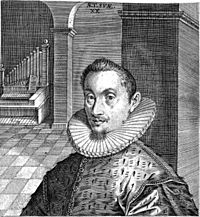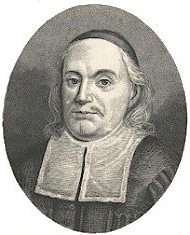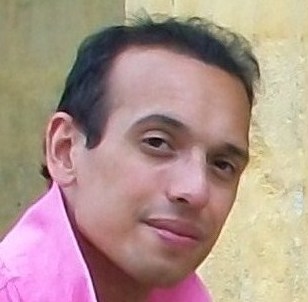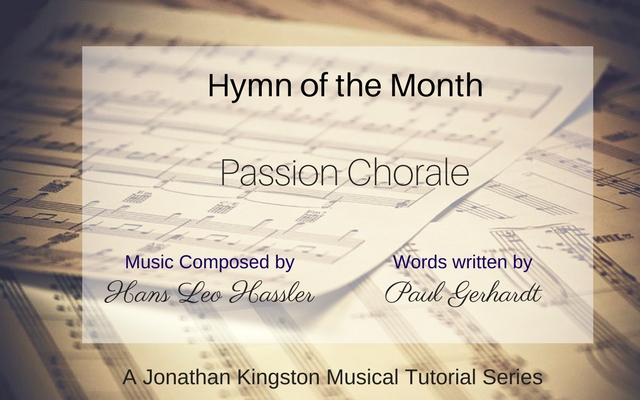The hymn tune of the month this time is “Passion Chorale” which was originally composed by Hans Leo Hassler (1564-1612). The most common text associated to this hymn tune is “O Sacred Head, Now Wounded” which is a Christian Passion hymn based on a Latin text written during the Middle Ages. Paul Gerhardt (1607-1676) originally wrote a German version “O Haupt voll Blut und Wunden” that was then subsequently translated many different times to English. Many other composers have since written organ music based on this tune.

Hans Leo Hassler, born in Nuremburg, was a German composer and organist of the late Renaissance and early Baroque eras. He came from a family of famous musicians, receiving his early education from his father, with his elder brother Jakob Hassler also being an accomplished composer. Hans later studied in Venice with Andrea Gabrieli where he learned the polychoral style which he brought back to Germany. Hassler served as organist and composer in Augsburg, then director of town music and organist in the Nuremberg, and finally as court musician in Dresden.
Hassler’s original melody was composed for a love song called “Mein G’mut ist mir verwirret”, which appeared in print in 1601. The tune was appropriated and simplified for Gerhardt’s German hymn in 1656 by Johann Crüger. Johann Sebastian Bach arranged the tune and used it as a Chorale in his “St. Matthew Passion” oratorio. He also used the tune in his “Christmas Oratorio” but with different words.

The powerful Passion hymn “O Sacred Head, Now Wounded” can be found in quite distinct English translations as well as many hybrid versions. The hymn is based on a medieval poem called “Salve Mundi Salutare” written in Latin. It is often attributed to Bernard of Clairvaux, but this is also disputed by many. In the mid seventeenth century part of the poem was translated by Paul Gerhardt. The first English translation was made in 1752 but a more common version was translated by James Waddell Alexander in 1830. However, one of the most commonly found versions in modern hymnbooks is by Robert Bridges in 1899 which has the slightly different title “O Sacred Head, Sore Wounded”.
This is played on a custom built Envoy 23-S, which is a very popular church instrument.
More About Jonathan Kingston’s Musical Background
 Jonathan studied the organ with Professor Ian Tracey and Ian Wells of Liverpool’s Anglican Cathedral, home to one of the largest pipe organs in the world. He was appointed Organ Scholar, and subsequently Sub-Organist to Bradford Cathedral before securing positions as Assistant Director and Director of Music at two leading independent schools. He is currently Associate Director of Music at the Ordinariate Church of Our Lady of the Assumption, Piccadilly.
Jonathan studied the organ with Professor Ian Tracey and Ian Wells of Liverpool’s Anglican Cathedral, home to one of the largest pipe organs in the world. He was appointed Organ Scholar, and subsequently Sub-Organist to Bradford Cathedral before securing positions as Assistant Director and Director of Music at two leading independent schools. He is currently Associate Director of Music at the Ordinariate Church of Our Lady of the Assumption, Piccadilly.
Jonathan’s Work With Viscount
Jonathan works with us as our very own in house organist – he covers several areas from sales, demonstrations, voicing of instruments and performing. His playing features on the current promotional DVD material for Viscount, and he would be very pleased to hear from any churches or individuals requiring an engaging and lively recitalist. If you would like to connect with Jonathan directly, please feel free to follow him on Twitter (@jonkingston) or by email on jonkingston@hotmail.co.uk.
More About the Organ Being Played In This Demonstration
Jonathan plays this piece on an instrument based on our Envoy 23-S. A ‘Physical Modelling’ based instrument with 23 stops in a real wood veneer cabinet. It has a huge internal library allowing the user to create 4 totally individual voice pallets from classic English through Baroque and Romantic. It benefits from a full complement of divisional thumb pistons and additional toe pistons. The standard 23-S organ has a 30 note pedal board while the instrument in the film has a 32 note board. For more information have a look at the specifications here.
I have had a passion for church organs since the tender age of 12. I own and run Viscount Organs with a close attention to the detail that musicians appreciate; and a clear understanding of the benefits of digital technology and keeping to the traditional and emotional elements of organ playing.




I have just listened to the viscount organ being played
I am very impressed with its beautiful sound an So like
a Pipe Organ.
The best digital I have heard.